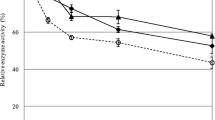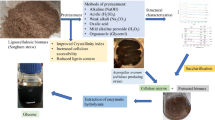Abstract
In order to explore the effect of additives on enzymatic hydrolysis of lignocellulose biomass, the effect of two different additives, Triton X-100 (TX-100) and Bovine serum albumin (BSA), enzyme dosages, and additive concentrations on enzymatic hydrolysis to obtain fermentable sugar using cellulose extracted from wheat straw (WS) as the substrate was investigated in this study. An enzymatic hydrolysis kinetic model was used to successfully describe the enzymatic hydrolysis in a heterogeneous system. Fourier transform infrared spectroscopy (FTIR) and scanning electron microscope (SEM) were used to determine the effect of extraction and enzymatic hydrolysis on the composition and structure of the samples. The results showed that the total reducing sugar concentration of the raw was 1.535 g/L at 120 h, but that of the extracted cellulose (EC) increased to 5.087 g/L at 120 h, indicating that EC from WS is more conducive to enzymatic hydrolysis compared with the raw. The total reducing sugar concentration with the addition of the TX-100 was 6.737 g/L at 120 h, which was greater than that with the addition of the BSA (5.728 g/L at 120 h), indicating that the addition of two additives improved the enzymatic hydrolysis efficiency, especially TX-100. The kinetic studies showed that the initial enzymatic hydrolysis reaction rate (Km) of the EC was more than four times greater than that of the raw. The Km of the EC added with TX-100 and BSA were increased by 29.50% and 22.89% compared with that of the EC without the addition of additive. The addition of additives is an effective method for enhancing enzymatic hydrolysis efficiency and fermentable sugar production from lignocellulosic biomass.



Similar content being viewed by others
Data Availability
The authors confirm that all data underlying the findings are fully available without restriction. All relevant data are within the paper.
References
Poddar, B. J., Nakhate, S. P., Gupta, R. K., Chavan, A. R., Singh, A. K., Khardenavis, A. A., & Purohit, H. J. (2022). A comprehensive review on the pretreatment of lignocellulosic wastes for improved biogas production by anaerobic digestion. International Journal of Environmental Science and Technology, 19, 3429–3456. https://doi.org/10.1007/s13762-021-03248-8
Kamaraj, M., Ramachandran, K. K., & Aravind, J. (2020). Biohydrogen production from waste materials: Benefits and challenges. International Journal of Environmental Science and Technology, 17, 559–576. https://doi.org/10.1007/s13762-019-02577-z
Sharma, H. K., Xu, C., & Qin, W. (2019). Biological pretreatment of lignocellulosic biomass for biofuels and bioproducts: An overview. Waste and Biomass Valorization, 10, 235–251. https://doi.org/10.1007/s12649-017-0059-y
Sadh, P. K., Duhan, S., & Duhan, J. S. (2018). Agro-industrial wastes and their utilization using solid state fermentation: A review. Bioresources and Bioprocessing, 5, 1–15. https://doi.org/10.1186/s40643-017-0187-z
Paul, A. S., Panwar, N. L., Salvi, B. L., Jain, S., & Sharma, D. (2020). Experimental investigation on the production of bio-oil from wheat straw. Energy Sources, Part A: Recovery, Utilization and Environmental Effects. https://doi.org/10.1080/15567036.2020.1779416
Manzanares, P. (2020). The role of biorefinering research in the development of a modern bioeconomy. Acta Innovations, 37, 47–56. https://doi.org/10.32933/actainnovations.37.4
Gírio, F. M., Fonseca, C., Carvalheiro, F., Duarte, L. C., Marques, S., & Bogel-Łukasik, R. (2010). Hemicelluloses for fuel ethanol: A review. Bioresource Technology, 101, 4775–4800. https://doi.org/10.1016/j.biortech.2010.01.088
Aguirre-Fierro, A., Ruiz, H. A., Cerqueira, M. A., Ramos-Gonzalez, R., Rodríguez-Jasso, R. M., Marques, S., & Lukasik, R. M. (2020). Sustainable approach of high-pressure agave bagasse pretreatment for ethanol production. Renewable Energy, 155, 1347–1354. https://doi.org/10.1016/j.renene.2020.04.055
Yang, C., Shen, Z., Yu, G., & Wang, J. (2008). Effect and aftereffect of γ radiation pretreatment on enzymatic hydrolysis of wheat straw. Bioresource Technology, 99, 6240–6245. https://doi.org/10.1016/j.biortech.2007.12.008
Wu, M., Liu, H., Guo, J., & Yang, C. (2018). Enhanced enzymatic hydrolysis of wheat straw by two-step pretreatment combining alkalization and adsorption. Applied Microbiology and Biotechnology, 102, 9831–9842. https://doi.org/10.1007/s00253-018-9335-4
Zhao, L., Sun, Z., Zhang, C., Nan, J., Ren, N., Lee, D., & Chen, C. (2022). Advances in pretreatment of lignocellulosic biomass for bioenergy production: Challenges and perspectives. Bioresource Technology, 343, 126123. https://doi.org/10.1016/j.biortech.2021.126123
Klein-Marcuschamer, D., Oleskowicz-Popiel, P., Simmons, B. A., & Blanch, H. W. (2012). The challenge of enzyme cost in the production of lignocellulosic biofuels. Biotechnology & Bioengineering, 109(4), 1083–1087. https://doi.org/10.1002/bit.24370
Padella, M., O’Connell, A., & Prussi, M. (2019). What is still limiting the deployment of cellulosic ethanol? Analysis of the current status of the sector. Applied Sciences, 21(9), 4523. https://doi.org/10.3390/app9214523
Ramos, L. P., Suota, M. J., Fockink, D. H., Pavaneli, G., da Silva, T. A., & Łukasik, R. M. (2020). Recent advances in bioconversion of lignocellulose to biofuels and value-added chemicals within the biorefinery concept: enzymes and biomass pretreatment (p. 61). https://doi.org/10.1016/B978-0-12-818223-9.00004-7
Pereira, P. M. A., Bernardo, J. R., Roseiro, L. B., Gírio, F., & Łukasik, R. M. (2021). Imidazole processing of wheat straw and eucalyptus residues-comparison of pre-treatment conditions and their influence on enzymatic hydrolysis. Molecules, 26, 7591. https://doi.org/10.3390/molecules26247591
Bernardo, J. R., Gírio, F. M., & Łukasik, R. M. (2019). The effect of the chemical character of ionic liquids on biomass pre-treatment and posterior enzymatic hydrolysis. Molecules, 24, 808. https://doi.org/10.3390/molecules24040808
da Silva, A. S. A., Espinheira, R. P., Teixeira, R. S. S., de Souza, M. F., Ferreira-Leitao, V., & Bon, E. P. S. (2020). Constraints and advances in high-solids enzymatic hydrolysis of lignocellulosic biomass: A critical review. Biotechnology for Biofuels, 13, 58. https://doi.org/10.1186/s13068-020-01697-w
Xu, C., Zhang, J., Zhang, Y., Guo, Y., Xu, H., Xu, J., & Wang, Z. (2019). Enhancement of high-solids enzymatic hydrolysis efficiency of alkali pretreated sugarcane bagasse at low cellulase dosage by fed-batch strategy based on optimized accessory enzymes and additives. Bioresource Technology, 292, 121993. https://doi.org/10.1016/j.biortech.2019.121993
Vergara, P., Ladero, M., Carbajo, J. M., García-Ochoa, F., & Villar, J. C. (2021). Effect of additives on the enzymatic hydrolysis of pre-treated wheat Straw. Brazilian Journal of Chemical Engineering, 38, 241–249. https://doi.org/10.1007/s43153-021-00092-8
Mukasekuru, M. R., Kaneza, P., Sun, H., Sun, F. F., He, J., & Zheng, P. (2020). Fed-batch high-solids enzymatic saccharification of lignocellulosic substrates with a combination of additives and accessory enzymes. Industrial Crops and Products, 146, 112156. https://doi.org/10.1016/j.indcrop.2020.112156
Rocha-Martín, J., Martinez-Bernal, C., Pérez-Cobas, Y., Reyes-Sosa, F. M., & García, B. D. (2017). Additives enhancing enzymatic hydrolysis of lignocellulosic biomass. Bioresource Technology, 244, 48–56. https://doi.org/10.1016/j.biortech.2017.06.132
Agrawal, R., Satlewal, A., Kapoor, M., Mondal, S., & Basu, B. (2017). Investigating the enzyme-lignin binding with surfactants for improved saccharification of pilot scale pretreated wheat straw. Bioresource Technology, 224, 411–418. https://doi.org/10.1016/j.biortech.2016.11.026
Zhang, H., Huang, S., Wei, W., Zhang, J., & Xie, J. (2019). Investigation of alkaline hydrogen peroxide pretreatment and Tween 80 to enhance enzymatic hydrolysis of sugarcane bagasse. Biotechnology for Biofuels, 12, 107. https://doi.org/10.1186/s13068-019-1454-3
Li, K., Wang, X., Wang, J., & Zhang, J. (2015). Benefits from additives and xylanase during enzymatic hydrolysis of bamboo shoot and mature bamboo. Bioresource Technology, 192, 424–431. https://doi.org/10.1016/j.biortech.2015.05.100
Kim, M. H., Lee, S. B., Ryu, D. D. Y., & Reese, E. T. (1982). Surface deactivation of cellulose and its prevention. Enzyme and Microbial Technology, 4, 99–103. https://doi.org/10.1016/0141-0229(82)90090-4
Yang, B., & Wyman, C. E. (2006). BSA treatment to enhance enzymatic hydrolysis of cellulose in lignin containing substrates. Biotechnology & Bioengineering, 94(4), 611–617. https://doi.org/10.1002/bit.20750
Kumar, L., Arantes, V., Chandra, R., & Saddler, J. (2012). The lignin present in steam pretreated softwood binds enzymes and limits cellulose accessibility. Bioresource Technology, 103(1), 201–208. https://doi.org/10.1016/j.biortech.2011.09.091
Harrison, M. D., Zhang, Z., Shand, K., Chong, B. F., Nichols, J., Oeller, P., O’Hara, I. M., Doherty, W. O. S., & Dale, J. L. (2014). The combination of plant-expressed cellobiohydrolase and low dosages of cellulases for the hydrolysis of sugarcane bagasse. Biotechnology for Biofuels, 7, 131. https://doi.org/10.1186/s13068-014-0131-9
Van Soest, P. J., Robertson, J. B., & Lewis, B. A. (1991). Methods for dietary fiber, neutral detergent fiber, and nonstarch polysaccharides in relation to animal nutrition. Journal of Dairy Science, 74(10), 3583–3597. https://doi.org/10.3168/jds.S0022-0302(91)78551-2
Ghose, T. K. (1987). Measurement of cellulase activities. Pure and Applied Chemistry, 59(2), 257–268. https://doi.org/10.1351/pac198759020257
Zhang, H., Fan, M., Li, X., Zhang, A., & Xie, J. (2018). Enhancing enzymatic hydrolysis of sugarcane bagasse by ferric chloride catalyzed organosolv pretreatment and Tween 80. Bioresource Technology, 258, 295–301. https://doi.org/10.1016/j.biortech.2018.03.004
Miller, G. L. (1959). Dinitrosalicylic acid reagent for determination of reducing sugars. Analytical Chemistry, 31(3), 426–428. https://doi.org/10.1021/ac60147a030
Deng, Z., Xia, A., Liao, Q., Zhu, X., Huang, Y., & Fu, Q. (2019). Laccase pretreatment of wheat straw: Effects of the physicochemical characteristics and the kinetics of enzymatic hydrolysis. Biotechnology for Biofuels, 12, 159. https://doi.org/10.1186/s13068-019-1499-3
Cui, M., Hu, Y., Li, B., & Wang, R. Effects of non-ionic surfactants on bioethanol production using extracted cellulose from wheat straw and kinetic studies. Biomass Conversion and Biorefinery. https://doi.org/10.1007/s13399-021-01421-0
Fockink, D. H., Andreaus, J., Ramos, L. P., & Łukasik, R. M. (2020). Pretreatment of cotton spinning residues for optimal enzymatic hydrolysis: A case study using green solvents. Renewable Energy, 145, 490–499. https://doi.org/10.1016/j.renene.2019.06.042
Mirmohamadsadeghi, S., Chen, Z., & Wan, C. (2016). Reducing biomass recalcitrance via mild sodium carbonate pretreatment. Bioresource Technology, 209, 386–390. https://doi.org/10.1016/j.biortech.2016.02.096
Yu, H., Xiao, W., Han, L., & Huang, G. (2019). Characterization of mechanical pulverization/phosphoric acid pretreatment of corn stover for enzymatic hydrolysis. Bioresource Technology, 282, 69–74. https://doi.org/10.1016/j.biortech.2019.02.104
Chaikumpollert, O., Methacanon, P., & Suchiva, K. (2004). Structural elucidation of hemicellulose from votives grass. Carbohydrate Polymers, 57(2), 191–196. https://doi.org/10.1016/j.carbpol.2004.04.011
Wang, W., Yuan, T. Q., & Cui, B. K. (2013). Fungal treatment followed by FeCl3 treatment to enhance enzymatic hydrolysis of poplar wood for high sugar yields. Biotechnology Letters, 35, 2061–2067. https://doi.org/10.1007/s10529-013-1306-3
Ling, Z., Chen, S., Zhang, X., & Xu, F. (2017). Exploring crystalline-structural variations of cellulose during alkaline pretreatment for enhanced enzymatic hydrolysis. Bioresource Technology, 224, 611–617. https://doi.org/10.1016/j.biortech.2016.10.064
Acknowledgements
Thanks for the technology support of FTIR and SEM provided by the experimental management center of the Henan Institute of Science and Technology.
Funding
The authors would like to thank the Henan Institute of Science and Technology for financial support (No. 210010611001).
Author information
Authors and Affiliations
Contributions
Maojin Cui conceived and designed this research. Xiaoyu Li performed the experiments. All authors analyzed the data and wrote the manuscript.
Corresponding author
Ethics declarations
Ethics Approval
Not applicable.
Consent to Participate
All authors have given consent to participate.
Consent for Publication
All authors have given approval of the manuscript to be published.
Competing Interests
The authors declare no competing interests.
Additional information
Publisher’s Note
Springer Nature remains neutral with regard to jurisdictional claims in published maps and institutional affiliations.
Rights and permissions
Springer Nature or its licensor (e.g. a society or other partner) holds exclusive rights to this article under a publishing agreement with the author(s) or other rightsholder(s); author self-archiving of the accepted manuscript version of this article is solely governed by the terms of such publishing agreement and applicable law.
About this article
Cite this article
Cui, M., Li, X. Additives Enhancing Enzymatic Hydrolysis of Wheat Straw to Obtain Fermentable Sugar. Appl Biochem Biotechnol 195, 1059–1071 (2023). https://doi.org/10.1007/s12010-022-04200-3
Accepted:
Published:
Issue Date:
DOI: https://doi.org/10.1007/s12010-022-04200-3




